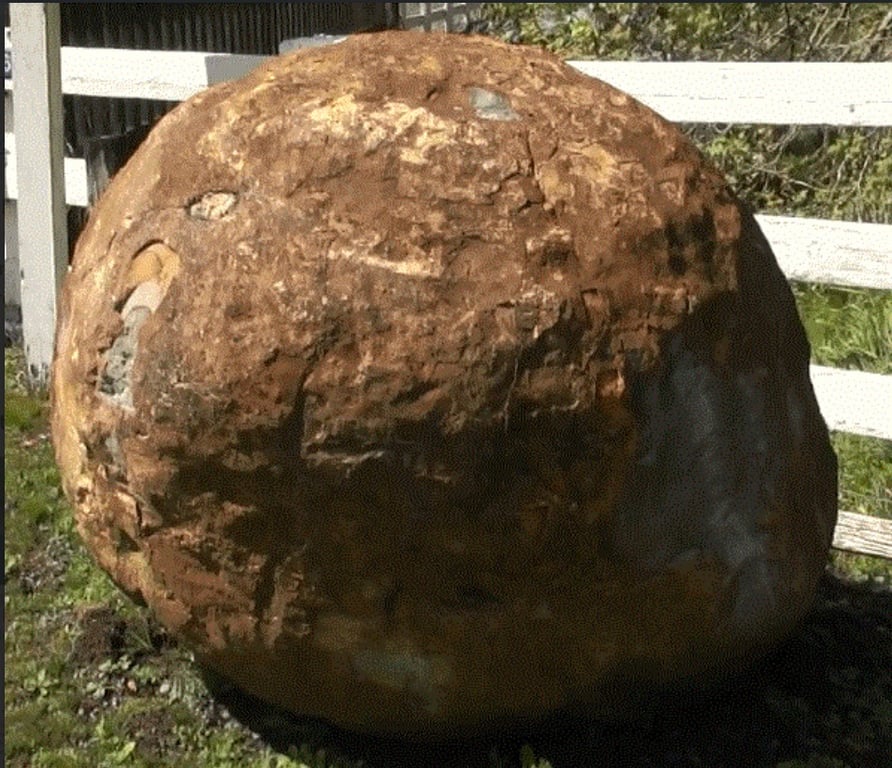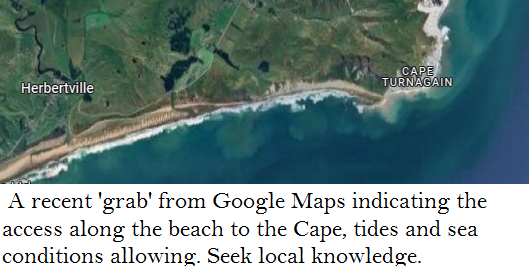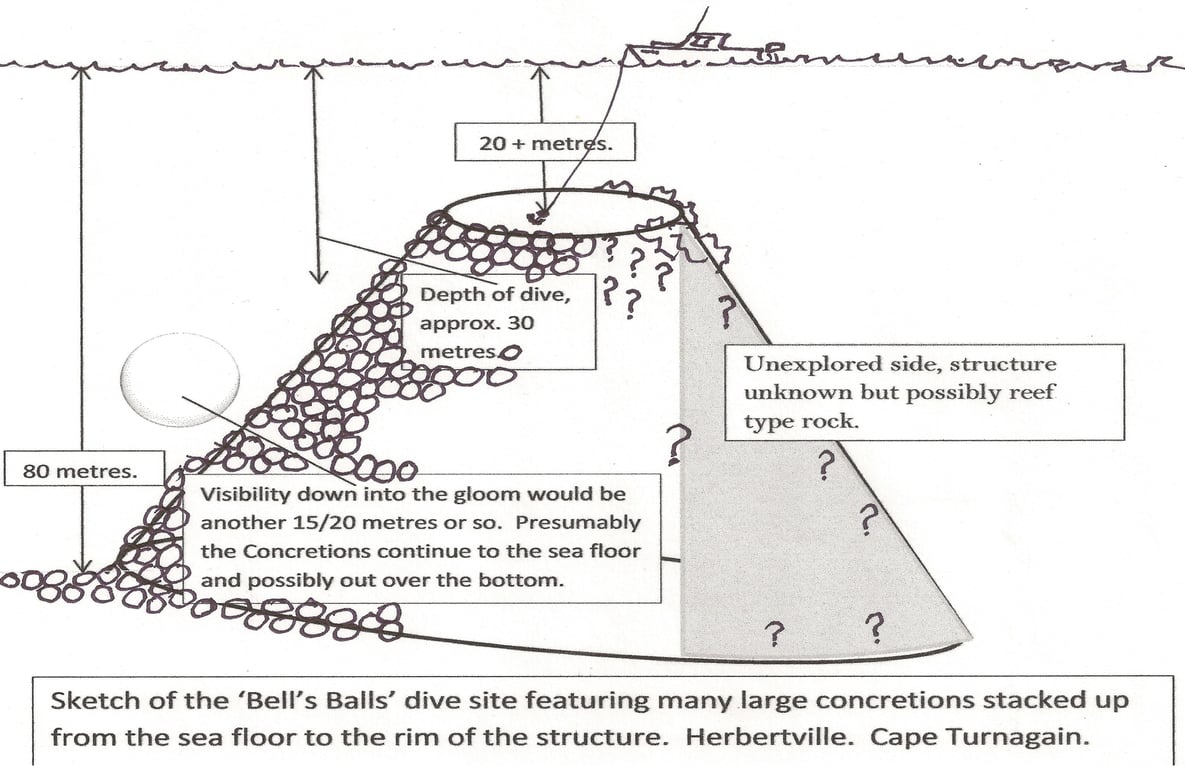Bell's Balls
A campground dive led Noel Bell to a fascinating discovery

Kiwi diver Noel Bell got in touch with Dive Pacific about an exciting new dive site on the east coast of New Zealand's North Island in the hope of finding a skipper who can help him find out more about these intriguing phenomena.
Many years ago (over 20 of them) with my nephew Andy Bell, we bought a ‘permanent site’ in the Herbertville Campground, around 68km east of Dannevirke. This is an old-style coastal camping ground, which at the time was ably owned and operated by Val and Dave Sunnex. The camp was often referred to as a fishing camp, as at holiday time the camp would fill up with trailer boats and suitable vehicles, tractors, dune buggies, quads, and various types of vehicles to drag the boats along the beach to the cape… Cape Turnagain that is, where Captain Cook ‘turned again’ on his voyage around New Zealand.

We, along with most other locals and campers, would trundle our boats along the road/beach (about 6 kilometres) to enjoy the wonderful fishing and diving that is on offer here. It was during these fabulous dives that we discovered a huge heap of concretions that may be up against a rocky structure.
The concretions around the general Herbertville area that I saw, vary from about 300mm to about 1.5 metres in size.
The ones on the dive site are roughly spherical and about 1.2m in diameter; they all looked identical, fairly smooth and of a muddy green/brown colour which is probably a mossy weed covering. It looked as if there were hundreds or maybe even thousands of them! A mathematician can approximate the number and I'm happy to provide more facts here.
What is a 'concretion'?
A concretion is a hard, compact mass, formed by the precipitation of mineral cement within the spaces between particles. They are generally round in shape. One explanation I found says concretions "...only 'grow' in a sea sedimentary environment over millions of years. In some respects they grow like a pearl will grow in an oyster."
A good example of concretions is to look at Moeraki Boulders. However, the ones we discovered are not split; the land-based ones do break down when exposed to certain weather conditions.
Where to dive
From memory, the dive site is about a kilometre offshore, maybe a little less, on the sounder it shows similar to a rock with around 20+/- metres over it, on the landward side it rises out of 80m of water but the sea floor slopes down towards the outer edge, so that outer edge at a guess could be in around 130m of water, I haven’t been around that side.

On my first dive, dive, we anchored on top of the ‘rock’ and dropped into the water. The visibility was just unbelievable - the lateral vis must have been in the region of 50m. From the surface you could see the little stones on the bottom quite clearly. The top of the rock is flattish, rubble-strewn and roughly elliptical, and measures around 35m x 20m. During my dives I simply headed shoreward, approximately north, to the rim of the rubble area.
Swimming to the edge the sight that greeted me was mind boggling, there was nothing but identical looking rock balls in all directions, left, right and disappearing into the inky blue of deep water, I slowly descended down the side to a depth of around 30 metres, there was no end of the rock balls in any direction, it would be fair to presume that they continued to the sea floor and perhaps continued into the muddy bottom some more.
I can recall being mesmerised by what I could see, I did enter some of the holes made by the roundness of the rock balls to see what was going on inside but it was too dark. I just ended up with a necklace of tiny crayfish around my neck and shoulders! I could get my head and shoulders in but no more: the tank would have stopped further entry anyway.

The rock is far enough offshore to miss the grey wash caused by the soft sandstone or mudstone material of the Cape sea cliffs that stuffs up the inshore diving/fishing. The visibility when I have been there has been exceptional, Poor Knights style. In fact if this site was at the Poor Knights it would be a ‘must dive’ for every visitor!
For clarity, I have not measured anything and my estimates are (un)educated guesswork, so maybe some learned law of relativity could be conjured up to get some sort of estimation of the number of concretions in this underwater structure.
Big balls!
The approximate diameter of the rock balls may be able to be gained by my being able to get head and shoulders into the gaps but 1.1m would be close. From memory, the top of the rock is around 35 x 20m. I dived in about the centre of the 35m axis and the rock balls spread out of sight by the curvature both ways. This would give the approximate number of balls in the top row. The height of the rock itself is around 55 metres.
The angle is the hardest to evaluate. The angle is not steep, the rock balls are stable, and I saw no evidence of any having rolled off or showing any movement at all, even though the general area does get some significant earthquakes. Any calculation is approximate, as it only gives us the number of rock balls on the outer side; however it is fair enough to presume that there are significant layers underneath!
As far as I know, only two of us have actually seen these concretions: myself, and a good friend, Ritchie Haagh, who spent a bit of time at our Herbertville camp site. He had a dive or two off the Cape and observed these concretions. He can confirm they exist - which is good for me as I feel sometimes that when explaining thes strange underwater structure to others they don't believe me! Ritchie was well-known in diving circles around Wellington being a previous owner of the Dive Spot dive/fishing shop and ran a serious dive school at Paremata, Porirua. He later became deeply involved with commercial diver training at the Omne Marine Group in Huntly.
Intrigued?
Noel would very much like to reach out to the skipper of any vessel, private, commercial, fishing, that is in or passing the area to survey the site and supply a word picture, some underwater photos or videos, or vessels with suitable echo sounders perhaps with a side scanner preferably with recording capability… in fact anything at all!
Noel has the GPS position of this significant site, and is very happy to supply it on application with the understanding that any written report, photo, video or sounder recording is made available to me to allow further articles to follow.
Responders will be fully accredited with any material supplied.
If you're keen to find out more, contact Noel Bell at noel_bell@xtra.co.nz
Read more from
Dive Pacific
Dive Pacific is the media arm of the New Zealand Underwater Association


